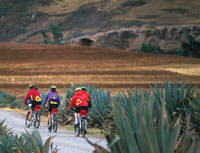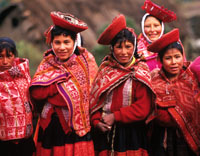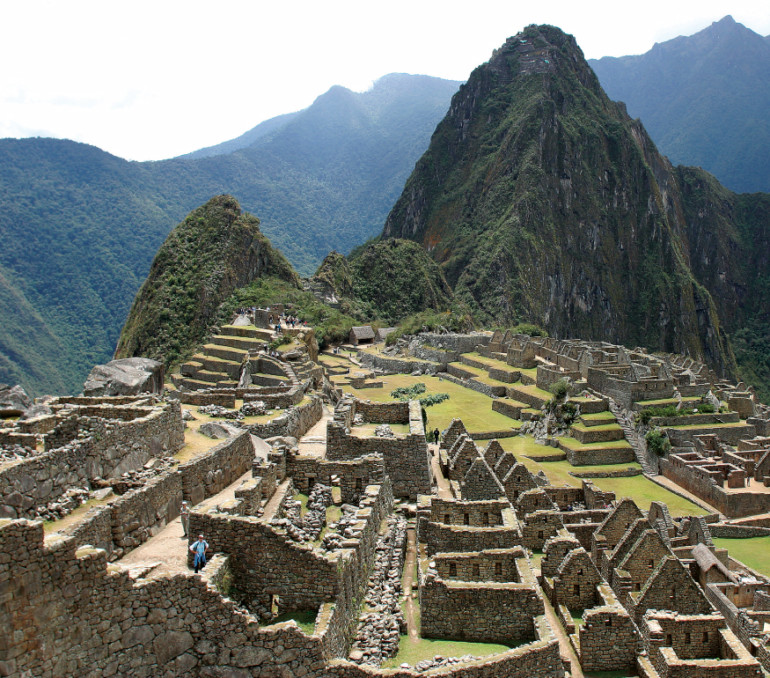I landed in Cusco, the ancient center of the Incan world, and my head was in a spin. Blame the 11,200-foot elevation and the red-eye flight from Miami to Lima, plus a healthy dose of disorientation. Our main guide, Canadian Pam Frich, met me at Cusco’s modest airport and had a quick remedy—sorochi pills, a local antidote for altitude sickness. She also advised I avoid drinking alcohol and instead have the coca tea available in the lobby of our hotel, the luxurious Hotel Monasterio. The sorochi worked its magic on my mixed-up mind and body and after a day or so more of spinning I was feeling grounded enough to sip a pisco sour and celebrate my arrival in this faraway place.
Acclimatization is the key to an enjoyable visit to the lofty Peruvian Andes. It’s a good idea to take it easy for a couple of days after arrival. I had the good fortune to spend three days in the splendid surroundings of the Monasterio, formerly the colonial-era Old San Antonio Abad Seminary, built more than 300 years ago in the heart of old Cusco and now converted into our hotel. It was in this tranquil oasis, where monastic music imbues the ancient stone corridors throughout the day, that our group of 16 gathered for a week of hiking, biking and cultural exploration in the timeless landscape of Peru’s Sacred Valley.
First on our agenda: an introductory walk through Cusco. This onetime center of the Inca empire was transformed by Spanish conquistadors in the 16th century, and the old and new worlds blend here in a dizzying mélange of Incan and colonial architecture. The locals speak Spanish, native Quechua and, occasionally, English.
We ambled through ancient alleyways, many lined with monumental walls constructed of Incan stone. Each massive piece was carved with laserlike precision, fitting together to form fascinating oversize jigsaw puzzles.
In the local artists’ district, we came to the 16th-century adobe church of San Blas, whose ornate cedar pulpit is considered the finest example of baroque wood carving in the Americas. Nearby, we visited two of Cusco’s most significant cultural sites: Coricancha, a colonial church built atop the ruins of an Incan temple, and the main cathedral, filled with Spanish and Incan artwork. Later, we finished with an Incan beer overlooking the Plaza de Armas, the town’s grand central square.
Into the Andes

Cyclists cruise the wide open altiplano of Peru’s Sacred Valley
After a hearty early breakfast and a few cups of coca tea, we shuttled to 12,000 feet in the hills above Cusco. Today’s hike, almost entirely downhill, brought us through Tambo Machay, site of sacred ritual baths, then leveled out along a ridgeline with a wide view of the Cusco valley. As we passed through a small village where farmers were working the land with primitive hand tools and ox-drawn plows, two Incan women and their herd of llamas accompanied us on our descent to Puca Pucara, a former Incan military and administrative center. We walked amid the llamas until we stopped for lunch; an Incan music group played songs on traditional piped instruments as we ate.
Continuing downward, we came to the Temple of the Moon, where our guide, Aurelio, explained the role of celestial objects in the Incan religion, and to Quenco, a temple marked with rock carvings. Our meandering route saved the best for last: the massive Incan complex of Sacsayhuaman, often called the Stonehenge of the Andes. Like many Incan sites, the complex was used for both religious and military purposes. By late afternoon we were back in Cusco, shopping for handicrafts and sweaters made of soft alpaca wool.
Andes Up, Insides Down
On the third day, our group was feeling acclimatized, although a nasty stomach bug plagued a few. We shuttled by bus to Chinchero, even higher at 12,400 feet, and strolled through narrow streets to the colonial-era church, built on the ramparts of Incan stone work. After browsing a local market for crafts, blankets, handmade toys and rugs, we hopped on mountain bikes and headed down into the altiplano, following quiet roads through fields and farming villages to the large Incan agricultural terraces of Moray, huge circles etched into the hillsides. In the distance lay a vast panorama of glacier-covered mountain peaks and deep valleys.
Continuing our bike ride to the village of Maras, we stopped to hike a dirt path that winds down into the Urubamba Valley through a working salt mine—a honeycomb of tiny pools fed by underground salt springs that have been tapped and harvested for hundreds of years. We watched farmers rake and scrape the pools, harvesting bags of white salt, the purest of which is sold to the Japanese consumer market. We ended our day at our home for the next three nights, the peaceful Sol y Luna Lodge, whose hobbitlike cabanas are in the heart of the Sacred Valley, midway between Cusco and Machu Picchu.
A short drive away is Ollantaytambo, a peaceful town on the northern end of the Sacred Valley. It was a steep ascent up the old stone steps of the temple complex, then a winding route down on a contour of trails. We continued through town along the Patacanch River, stopping for a picnic lunch, then shuttled to the hillside village of Huilloc, a small Quechua weaving community, where traditional lifestyles have seen little change for hundreds of years.
Back on our bikes, we followed a mostly level, intermittently paved and dirt route along the Urubamba River. Farmers tended crops and herded cattle in the neighboring fields. At the ruins of Pisac, we took in sweeping views of the Sacred Valley and walls that once housed Incan tombs.
End of the Line: Machu Picchu
From Ollantaytambo, we caught the train to Machu Picchu, disembarking several miles before the end of the line at Aguas Calientes, where we began our most challenging hike of the week—an eight-mile uphill grunt with a 2,200-foot elevation gain. We stopped for lunch at Huinay Huayna, a onetime religious complex once used for Inca religious purposes; later, our route merged with the Inca Trail, the most renowned footpath in South America. Used for centuries by Incan messengers and pilgrims, it still contains stones and stairs laid in ancient times. We followed this trail to the Gate of the Sun for our first view of the spectacular lost Incan city of Machu Picchu.

Women villagers of the hillside village of Huilloc, a small Quecha weaving community.
Machu Picchu (“manly peak”) lies 43 miles northwest of Cusco and sits atop an 8,000-foot ridge that hides it from the Urubamba River gorge and cloud forest below. The ridge is between a block of highland and the massive peak of Huayna Picchu. The surrounding area is covered in dense bush, some of it covering pre-Columbian cultivation terraces.
This mountaintop place was most likely a royal estate and religious retreat. Built between 1460 and 1470, it held approximately 200 buildings—residences, temples, storage and other public structures—and was home to about 1,200 people, primarily women, children and priests. Most of the structures are built from granite blocks cut with bronze or stone tools and smoothed with sand. The blocks fit together without mortar, although none are the same size. Most joints are so tight that even the thinnest of knife blades can’t be forced between the stones.
Even in its time, few people were aware of Machu Picchu’s existence. A half-century later, 50 percent of Peru’s population had been killed by smallpox and other diseases the Spanish conquistadors had brought. By 1532, when the conqueror Pizarro came to Cusco, Machu Picchu was already forgotten. It remained more or less intact and was rediscovered in 1911 by Hiram Bingham, a professor from Yale.
We arrived late in the day. Most visitors were gone already and a fickle mix of mist, sun and fog shrouded the ancient city. We spent the last rays of the day enjoying this magical sight. A local bus brought us down to Aguas Calientes, where we settled in at the beautiful Machu Picchu Pueblo Hotel.
On the last full day of our Peruvian adventure, we explored Machu Picchu, some of us walking to the Inca drawbridge while others took on a physically challenging hike to the ruins of Huayna Picchu and the Temple of the Moon.
That afternoon we gathered for a guided hike that taught us about the significance of the sun-worshipping Incans’ astrological creations. Machu Picchu is the site of an intihuatana, a column of stone rising from a block of stone the size of a grand piano. The word is usually translated as “hitching post of the sun”: As the winter solstice approached and the sun began disappearing earlier each day, an Incan priest led a ceremony to tie the sun to the intihuatana so it would not vanish altogether. Spanish conquistadors destroyed Peru’s other intihuatanas, but because they never found Machu Picchu, its hitching post remained intact.


